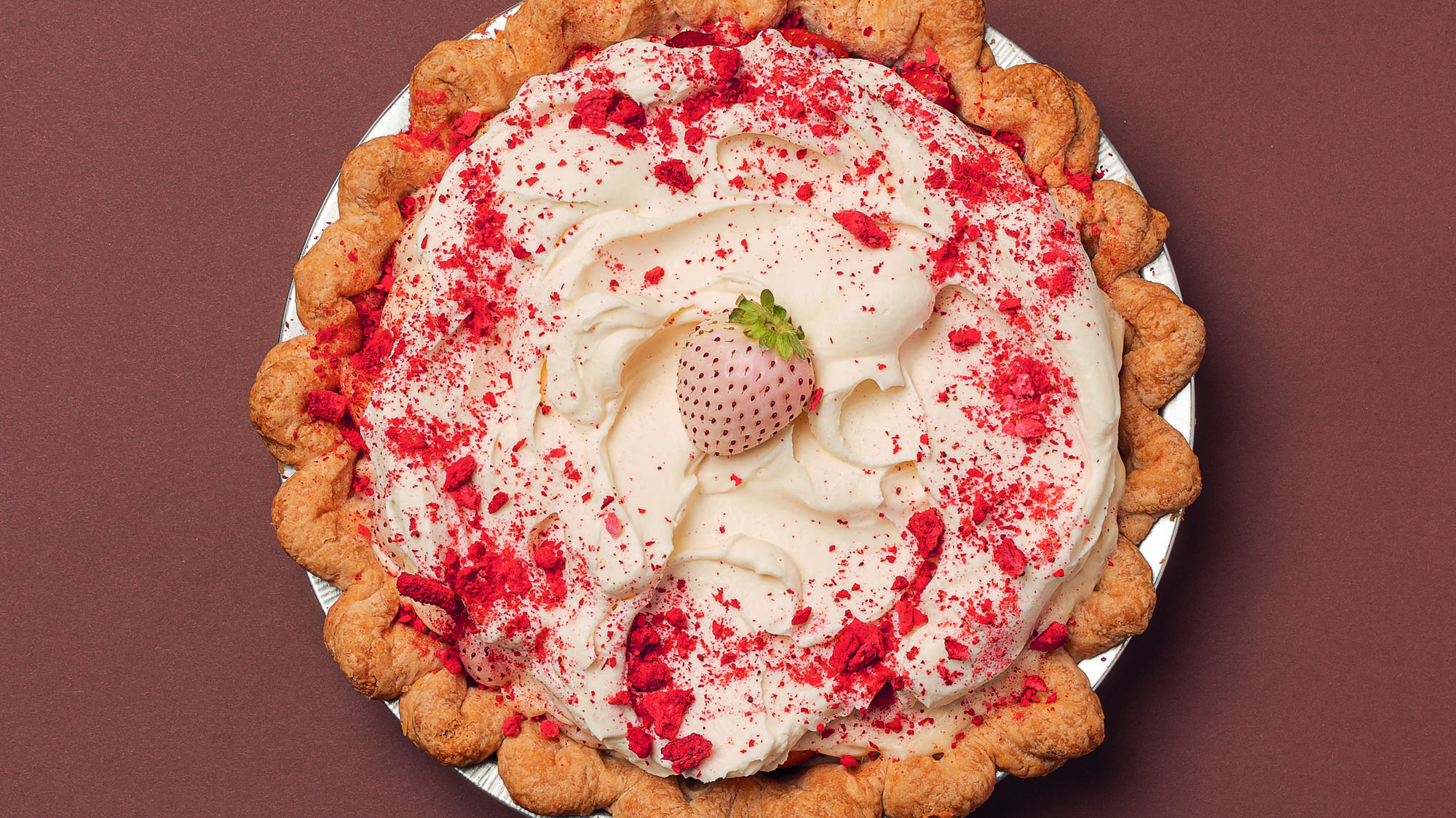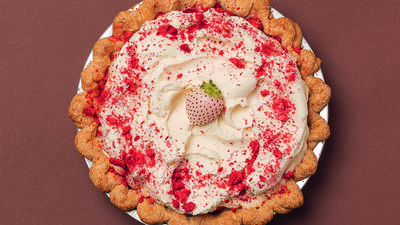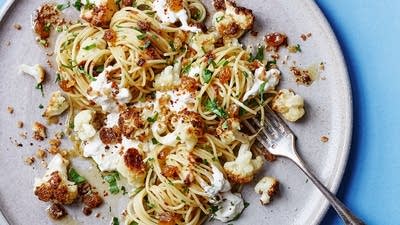
A classic combo of sweet strawberries and lightly sweetened cream. The filling in this pie gets an extra zhuzh from some mascarpone cheese, which creates a slightly stiffer pudding to cradle the juicy strawberry slices, and to give some added flair; you can use crushed freeze-dried strawberries for even more strawberry flavor.
Makes one 9-inch pie
INGREDIENTS
 Fat + Flour: The Art of a Simple Bake: A Cookbook
Nicole Rucker
Fat + Flour: The Art of a Simple Bake: A Cookbook
Nicole Rucker
For the Mascarpone–White-Chocolate Pudding
⅓ cup (78ml) heavy cream
⅓ cup (56g) roughly chopped white chocolate
3.4 ounces (96g) instant vanilla pudding mix
1 ¼ cups (295ml) whole milk
½ cup (120g) mascarpone cheese
1 teaspoon (5g) vanilla bean paste
¼ teaspoon (1g) almond extract
Pinch of Diamond Crystal kosher salt
To Assemble the Pie
1 fully baked pie crust (½ recipe Fat + Flour Pie Dough, recipe follows, made in advance; see below)
1 pound (453g) fresh strawberries, sliced, + more for decoration
1 cup (236ml) heavy cream
2 tablespoons (14g) sifted confectioners’ sugar
1 ounce (28g) freeze-dried strawberries, crushed to a powder
DIRECTIONS
Make the mascarpone–white-chocolate pudding: In a medium microwave-safe mixing bowl, heat the cream in your microwave for 1 ½ minutes, until it’s hot but not simmering. Immediately add the white chocolate. Wait 1 minute, and then whisk until the chocolate is melted and the mixture is smooth and thick, like ganache. Set aside to cool to a warm room temperature.
Place the instant pudding mix into a large mixing bowl. Make a well in the center, and pour in about ⅓ cup (78ml) of the milk. Whisk vigorously until all the instant pudding mix has been incorporated and no dry lumps remain. Add the cooled chocolate, mascarpone cheese, remaining milk, the vanilla bean paste, almond extract, and salt, and whisk vigorously until the mixture is thickened, about 2 minutes.
Assemble the pie: Transfer half the pudding to the prepared pie crust and add the sliced strawberries, arranging them so they cover the entire surface of the pudding. Add the rest of the pudding, and smooth the surface with an offset spatula. Cover the pie with plastic wrap, and chill it in the fridge while you make the whipped cream.
In the bowl of an electric mixer fitted with the whisk attachment, combine the cream and confectioners’ sugar, and beat until soft peaks form. Pile the whipped cream on top of the pie, and swoosh it around with the back of a spoon.
Refrigerate the pie for at least 4 hours. When you are ready to serve the pie, sprinkle the crushed freeze-dried strawberries over the top, and add some fresh strawberries around the edge of the pie. Soak a kitchen towel in hot water and fold it in half. Place the cold pie dish on top of the towel to dislodge the buttery crust from the bottom of the dish, which will make slices of pie easier to remove. Slice using a warm knife, and store any leftovers in the fridge. They will keep for about 3 days.
Fat + Flour Pie Dough
This recipe is the basis of both my bakery and my reputation as a baker. It has traveled with me from job to job and, finally, to my own business, Fat + Flour. I used this crust recipe when I won four out of seven blue ribbons at the KCRW Good Food Piefest & Contest, a moment that shaped my career, and again when I won a blue ribbon in the National Pie Contest, which cemented my future in pie.
The method has changed over time, but the ratio of the measurements has always stayed the same. The secret to this recipe is two points in the process: dissolving the sugar and salt in the water, so that every speck of flour is hydrated by seasoned liquid; and using a stand mixer for a mostly hands- off mixing with just enough power to develop the right amount of gluten while keeping the dough cool.
Makes 2 portions of dough, enough for 2 single-crust pies or 1 double-crust pie
INGREDIENTS
2 tablespoons packed (26g) dark-brown sugar
2 teaspoons (10g) apple-cider vinegar
1 teaspoon (3g) Diamond Crystal kosher salt
2 ounces (60ml) cold water
2 ¾ cups (343g) unbleached all-purpose flour, + more for rolling
8 ounces (226g) cold unsalted butter, cubed
DIRECTIONS
In a measuring cup, combine the brown sugar, vinegar, salt, and water. Use a spoon to stir the mixture until the sugar and salt have dissolved. Chill the liquid in the freezer until it’s very cold but not frozen, and keep it in the fridge until you’re ready to use it.
In a stand mixer fitted with the paddle attachment, mix the flour and cold butter on low speed until the mixture resembles uneven pebbles with a few larger pieces of butter throughout, about 2 to 4 minutes.
Slowly add the cold liquid to the bowl, with the mixer running on low speed. Continue mixing on low speed until a chunky, shaggy dough forms and no dry bits remain, about 30 seconds.
Lightly dust a counter or cutting board with flour. Turn the dough out onto the counter, and gently knead it a few times, to bring it together into a cohesive dough. Shape the dough into a rectangle about 6 by 8 inches.
Lightly dust a rolling pin with flour. Position the dough with the short side facing you. While it is still pliable but cool, roll the dough out to an 8-by-12-inch rectangle.
Fold the bottom third of the dough two-thirds of the way toward the top.
Fold the remaining third of the dough down, so that it is on top of the rest of the dough, like you would fold a letter.
Cut the dough down the center into two portions, each of them measuring about 4 by 4 inches.
Wrap each portion of dough well in plastic, and gently round the corners to form each into a somewhat circular shape. Chill the dough for a minimum of 1 hour. Once it has chilled, you can roll it out and use it in any pastry-crust pie or handpie recipe. Unbaked dough can be kept frozen for up to 3 months.
How to Blind-bake Pie Crust
Blind-baking is simply baker-speak for baking the crust part of the way before assembling the pie. Over the years, I have gathered a lot of data about blind-baking pastry, and I have learned that this is one of the points in the pie process where things are most likely to take a turn for the worse. The biggest issue I see is slumped, underfilled, misshapen crusts. Nine times out of ten, this is the result of two things: using a pastry crust that is too close to room temp when it hits the oven, and underfilling the cavity of the crust with pie weights or beans. Provided that your oven is preheated and you follow the directions below, you will not have a weird, slumped crust—it’s nearly impossible for that to happen when the crust is at the correct temp and when there are enough weights or beans pressing into the crust to hold it up.
There are two types of blind-baked crust: parbaked, when the crust is partially baked before adding filling and returning the pie to the oven; and fully baked, when the crust is baked through and then filled with a filling that does not require further cooking. The method for making a perfect parbaked or fully baked crust is all about the prep. Here are the steps to success:
Lightly flour a work surface. Remove the dough from the fridge, and remove the plastic. If your dough has been chilled overnight, it will need to temper before being rolled; this usually takes 10 to 15 minutes. Once the dough is pliable, roll the disc out to a 12-inch circle. Use flour throughout the rolling process as needed to prevent sticking. Transfer the rolled dough to a 9-inch pie plate, and trim the edge to allow 1 inch of dough to hang over. Roll or fold the hanging edge of the dough over itself, using your thumb and forefinger to crimp it. Chill the crimped crust in the freezer until it is completely frozen.
Preheat your oven to 375°F (190°C). Spray the interior of the frozen crust with nonstick cooking spray, and line it with parchment paper or a large coffee filter. Fill the lined crust with pie weights or dried beans, making sure the weights go all the way up the walls of the plate; this prevents movement and slipping during baking.
For a parbaked pastry crust: Place the crust on the center rack of your oven, and bake for 25 minutes, until the edges become golden and the interior crust looks slightly translucent. Remove the crust from the oven and let cool for 15 minutes with the pie weights inside it before gently removing the parchment and weights and proceeding with the recipe.
For a fully baked pastry crust: Place the crust on the center rack of your oven, and bake for 30 minutes, until the edges become golden and the interior crust looks slightly translucent. Remove the crust from the oven, gently remove the parchment and weights, and return the crust to the oven to bake for an additional 7 to 10 minutes, until the interior crust is no longer translucent and has begun to take on a little golden color. Cool the crust completely before proceeding with the recipe.
From FAT + FLOUR © 2025 by Nicole Rucker. Excerpted by permission of Alfred A. Knopf, a division of Penguin Random House LLC. All rights reserved. No part of this excerpt may be reproduced or reprinted without permission in writing from the publisher.
When you shop using our links, we earn a small commission. It’s a great way to support public media at no extra cost to you.
Before you go...
Each week, The Splendid Table brings you stories that expand your world view, inspire you to try something new, and show how food connects us all. We rely on your generous support. For as little as $5 a month, you can have a lasting impact on The Splendid Table. And, when you donate, you’ll join a community of like-minded individuals who love good food, good conversation, and kitchen companionship. Show your love for The Splendid Table with a gift today.
Thank you for your support.
Donate today for as little as $5.00 a month. Your gift only takes a few minutes and has a lasting impact on The Splendid Table and you'll be welcomed into The Splendid Table Co-op.



